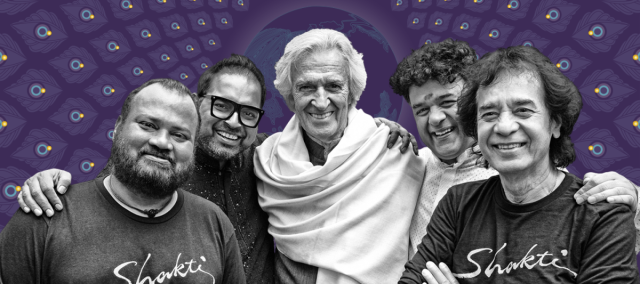Home > Jazz / Blues
09/08/2023
Shakti 50th Anniversary Tour / Schnitzer Concert Hall, September 5, 2023 / Review
By MICHAEL SHOEHORN CONLEY // Shakti took to the stage with the four instrumentalists seating themselves cross-legged on a raised platform. In the very beginning they sounded almost tentative, McLaughlin playing a riff which gave way to intricate unison lines with the violinist Ganesh Rajagopalan, with the two percussionists laying out during the beginning of this very consonant piece, which had a soothing quality reminiscent of a soul ballad or a quality pop instrumental.
Shakti is the iconic world music band started by guitarist John McLaughlin and percussionist Zakir Hussain in 1973. They are touring in support of a new album, titled “This Moment”. Presented by Kalakendra Society for the Performing Arts of India in collaboration with PDX Jazz, the show was nearly sold out.
Long before there were yoga studios in every neighborhood, before Bollywood nights at art house theaters, and Bhangra dance parties at local clubs, “Mahavishnu” John McLaughlin was a devotee of an Indian guru called Sri Chinmoy, and recorded an album with “Devadip” Carlos Santana (Love Devotion Surrender). That record was inspired by the teachings of their guru and dedicated to saxophone demigod John Coltrane, who, like fellow tenorists Sonny Rollins and Yusef Latif, had nurtured an interest in Eastern spiritual concepts and practices.
He also formed a terrific fusion band called the Mahavishnu Orchestra, blending jazz and Indian musical concepts. Before that, McLaughlin, 81, had held the guitar chair in Tony Williams' Lifetime and Miles Davis’ electric bands as well.
Shakti has been through some ups and downs and periods of inactivity, but they proved to be in fine form at their tour stop in Portland Tuesday night. Their repertoire stretches the boundaries of Hindustani and Carnatic music from India, and included the tune “Shrini’s Dream” that developed out of a rehearsal recording by the band’s late mandolinist U. Srinavas, known as ‘Shrini” who died unexpectedly at age 45 in September of 2014.
Having seen Srinavas with the group in Portland on a previous tour, I can attest to his incredible prowess on his electrified, fretless mandolin. He is unforgettable.
Shakti took to the stage with the four instrumentalists seating themselves cross-legged on a raised platform. In the very beginning they sounded almost tentative, McLaughlin playing a riff which soon gave way to intricate unison lines with the violinist Ganesh Rajagopalan, with the two percussionists laying out during the beginning of this very consonant piece, which had a soothing harmonic quality reminiscent of a soul ballad or a quality pop instrumental.
The drums eventually made their presence known, and the audience had multiple opportunities to applaud at various inflection points during the ebb and flow of this opening number, which continued to build in intensity for 10 minutes or so.
Hussain was the first to speak to the crowd, but it was McLaughlin who introduced the fifth member of the band, the singer Shankar Mahadevan, who assumed his place on the podium between McLaughlin and violinist Rajagopalan. The ensuing number started with a violin cadenza over a faint, unseen drone instrument, with textures shifting between voice and violin unisons, a drum and voice segment, voice and guitar segments, et cetera, creating different effects by utilizing various recombinations of the five musicians.
There were a few pieces during this concert during which McLaughlin played crunchy rock chords, just long enough to suggest that type of mood before launching into his signature blazing runs, often articulated in precise unison with Hussain's tabla or the violinist. At one such point McLaughlin introduced a riff consisting of three groups of two notes answered by rhythm breaks with vocalizing by both percussionists and the lead singer. The guitarist also employed a guitar synth on certain numbers to provide some minimal orchestration or add a different tonal color to a solo excursion.
Vocalist Mahadevan, who is well-known in India as a film composer and recording artist, has a gift for tone and a mastery of intonation, extending to virtuosic melismatic scale work up and down the register. He would often enhance his performance by tracing his vocal patterns in the air with his right hand, which reminded me of a theremin player due to the extraordinary flexibility of his pitch combined with the movements.
This band carries a deep flavor of Indian culture despite featuring the world’s premier jazz fusion guitarist and a violin virtuoso in the group. The violinist, seated cross-legged like the other players, appeared to rest the headstock of his instrument on the floor– it was tucked under his chin and supported by the floor while he played, which is a position I had never seen before. Some of this violin playing was reminiscent of rhythmic fiddling over the percussion, but he also executed ornamentations with an almost exaggerated facility, and cut through the mix with a bright tone and confident attack.
The second percussionist, V. Selvaganesh, played several instruments, including the ghatam, a drum built like a clay pot, and a mridingam, a cigar-shaped drum played on both ends, with heads resembling those of a tabla. Selvaganesh is the son of the original Shakti ghatam player Vikku Vinayakram. Towards the end of the concert he took an extended solo turn on the kanjira, a small frame drum– deceptively small considering the deep tones he was able to elicit from the instrument. With one hand changing the tension on the skin, his other hand brought forth impressively swift volleys of percussive fancy.
While as a listener and reporter I often try to analyze what's happening on stage in real time, some of the figures the members of Shakti execute on their instruments are very difficult to count. One tune was in 5/4 time, others featured mixed meter, with odd-numbered note groupings and complex cross rhythms. Were they 32nd notes? 64th notes? How does one precisely count 16 notes in the space of one beat? Though I have long had an interest in this type of playing, and use Indian percussion syllables in my practice and teaching of tap dance, this stuff is on a whole ‘nother level!
At the point we felt the concert was drawing to an end, we also knew that we were going to get a solo turn by the tabla master Hussain. He did not disappoint. He began in a relatively relaxed manner before building his solo into a veritable exposition of percussive possibility, with a velocity and attack only conceivable due to his own recorded work and that of others from the tradition. The only way I could begin to reproduce the sound afterward was by fluttering my tongue as fast as it can go and trying to spit some accents!
The tabla has a hypnotic sound with deep, wet, round tones; chiming, rather metallic middle register notes; and pleasantly dry higher tones, each of which are accessed on different parts of the drum heads, which have three layers of concentric circles to enable such varied tone production. There's nothing quite like it in western percussion, or African percussion for that matter, and apparently the players are taught to master the parts through vocalizations, which is very fascinating to listen to. (check youtube!) Hussain also uses a small splash cymbal, which could be heard once in a while, though his hands are so quick I never saw him actually hit it. He also played some tiny shakers on one number, peppering an adagio guitar-synth wash and setting the stage for swooping lines from the violin.
Throughout the concert McLaughlin employed various tone qualities besides a clean jazz sound, including an aggressive rock tone, the aforementioned smoother synth sounds, a sort of retro 70s guitar EQ, and at one point a sound approaching a very rootsy, almost Appalachian timbre, like a diddy-bow or a banjo. He is a deep and phenomenal instrumentalist with few rivals.
It’s safe to posit that Shakti fans are nothing if not eclectic in their musical tastes, and that must have factored into the booking of a solo set by Nashville session ace Jerry Douglas to open this show. Douglas is widely known for his specialty, the Dobro, and he himself mentioned he was a bit surprised by this bit of programming. I had no idea he would be there, and when I first saw the guitars on stage, I was thinking they might have booked a mohan veena player, which is a type of guitar and playing style developed in India.
I am open-minded about including Americana in world music and jazz events, and Douglas is a seasoned pro with multiple Grammy awards to his credit. He got a good response from this Portland crowd. The Dobro, played with a handheld slide, provides a great color for rootsy Americana music, and I hope one day he gets a chance to perform here with his quintet.








Caleb Z
Great article! Sounds like an awesome show!